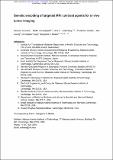| dc.contributor.author | Schuerle, Simone | |
| dc.contributor.author | Furubayashi, Maiko | |
| dc.contributor.author | Soleimany, Ava P. | |
| dc.contributor.author | Gwisai, Tinotenda | |
| dc.contributor.author | Huang, Wei | |
| dc.contributor.author | Voigt, Christopher A. | |
| dc.contributor.author | Bhatia, Sangeeta N | |
| dc.date.accessioned | 2020-05-28T21:41:34Z | |
| dc.date.available | 2020-05-28T21:41:34Z | |
| dc.date.issued | 2020-02 | |
| dc.date.submitted | 2019-10 | |
| dc.identifier.uri | https://hdl.handle.net/1721.1/125569 | |
| dc.description.abstract | Tumor-selective contrast agents have the potential to aid in the diagnosis and treatment of cancer using noninvasive imaging modalities such as magnetic resonance imaging (MRI). Such contrast agents can consist of magnetic nanoparticles incorporating functionalities that respond to cues specific to tumor environments. Genetically engineering magnetotactic bacteria to display peptides has been investigated as a means to produce contrast agents that combine the robust image contrast effects of magnetosomes with the transgenic-targeting peptides displayed on their surface. This work reports the first use of magnetic nanoparticles that display genetically encoded pH low insertion peptide (pHLIP), a long peptide intended to enhance MRI contrast by targeting the extracellular acidity associated with the tumors. To demonstrate the modularity of this versatile platform to incorporate diverse targeting ligands by genetic engineering, we also incorporated the cyclic αv integrin-binding peptide iRGD into separate magnetosomes. Specifically, we investigate their potential for enhanced binding and tumor imaging both in vitro and in vivo. Our experiments indicate that these tailored magnetosomes retain their magnetic properties, making them well suited as T2 contrast agents, while exhibiting an increased binding compared to the binding in wild-type magnetosomes. | en_US |
| dc.description.sponsorship | U.S. Army Research Office (Contract W911NF-09-0001) | en_US |
| dc.description.sponsorship | U.S. Army Research Office (Grant W911NF-19-2-0026) | en_US |
| dc.description.sponsorship | National Cancer Institute (Grant P30-CA14051) | en_US |
| dc.description.sponsorship | National Institute of Environmental Health Sciences (Grant P30-ES002109) | en_US |
| dc.language.iso | en | |
| dc.publisher | American Chemical Society (ACS) | en_US |
| dc.relation.isversionof | http://dx.doi.org/10.1021/acssynbio.9b00416 | en_US |
| dc.rights | Article is made available in accordance with the publisher's policy and may be subject to US copyright law. Please refer to the publisher's site for terms of use. | en_US |
| dc.source | bioRxiv | en_US |
| dc.title | Genetic Encoding of Targeted Magnetic Resonance Imaging Contrast Agents for Tumor Imaging | en_US |
| dc.type | Article | en_US |
| dc.identifier.citation | Schuerle, Simone et al. "Genetic Encoding of Targeted Magnetic Resonance Imaging Contrast Agents for Tumor Imaging." ACS Synthetic Biology 9, 2 (February 2020): 392–401 © 2020 American Chemical Society | en_US |
| dc.contributor.department | Harvard University--MIT Division of Health Sciences and Technology | en_US |
| dc.contributor.department | Massachusetts Institute of Technology. Research Laboratory of Electronics | en_US |
| dc.contributor.department | Massachusetts Institute of Technology. Department of Electrical Engineering and Computer Science | en_US |
| dc.contributor.department | Broad Institute of MIT and Harvard | en_US |
| dc.contributor.department | Massachusetts Institute of Technology. Synthetic Biology Center | en_US |
| dc.contributor.department | Massachusetts Institute of Technology. Department of Biology | en_US |
| dc.contributor.department | Koch Institute for Integrative Cancer Research at MIT | en_US |
| dc.relation.journal | ACS Synthetic Biology | en_US |
| dc.eprint.version | Original manuscript | en_US |
| dc.type.uri | http://purl.org/eprint/type/JournalArticle | en_US |
| eprint.status | http://purl.org/eprint/status/NonPeerReviewed | en_US |
| dc.date.updated | 2020-03-18T15:05:31Z | |
| dspace.date.submission | 2020-03-18T15:05:49Z | |
| mit.journal.volume | 9 | en_US |
| mit.journal.issue | 2 | en_US |
| mit.license | PUBLISHER_POLICY | |
| mit.metadata.status | Complete | |
